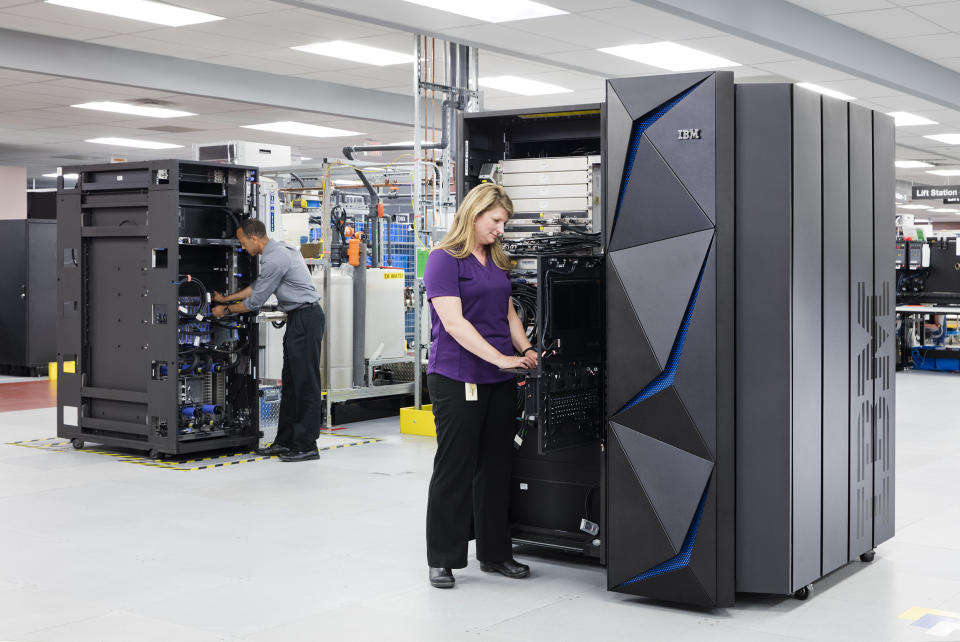Has International Business Machines (IBM) Finally Bottomed Out?
Shares of IBM (NYSE: IBM) jumped 8% on Jan. 23 after the tech giant's fourth-quarter numbers beat analyst expectations. Big Blue's revenue fell 3% annually to $21.8 billion, marking a second consecutive drop but surpassing estimates by $30 million. Its non-GAAP net income fell 8% to $4.4 billion and its non-GAAP EPS declined 6% to $4.87, which still beat expectations by a nickel.
On a GAAP basis, which included tax reform charges in the fourth quarters of 2017 and 2018, IBM posted a net profit of $2 billion -- compared to a loss of $1.1 billion a year ago. However, IBM's tax-related charges of $1.9 billion during the quarter were much lower than the $5.5 billion it paid last year.

Image source: IBM.
IBM expects its non-GAAP EPS to rise at least 0.7% to $13.90, compared to the consensus forecast for flat growth. That forecast includes gains from the recent sale of some of its software assets to HCL Technologies and its acquisition of Red Hat (NYSE: RHT), which should close in the second half of 2019. It also expects to generate $12 billion in free cash flow (FCF) for the full year, compared to $11.9 billion in 2018.
On the surface, Big Blue's growth still looks mediocre. Yet some investors might be wondering if IBM's post-earnings rally indicates that the stock -- which hit a multiyear low last month -- is finally ready to climb higher.
First, the bad news...
IBM's entire turnaround hinges on the growth of its "strategic imperatives" (SI), which include its higher-growth cloud, analytics, mobile, social, and security products and services. IBM's SI revenues rose 9% to $39.8 billion over the past 12 months and accounted for half of its top line. Unfortunately, that still represented a significant slowdown from its double-digit growth in previous quarters:
Metric | Q1 2018 | Q2 2018 | Q3 2018 | Q4 2018 |
|---|---|---|---|---|
SI revenue | $37.7 billion | $39.0 billion | $39.5 billion | $39.8 billion |
Year-over-year growth | 12% | 15% | 13% | 9% |
Data source: IBM quarterly reports.
IBM's total cloud revenue rose 12% to $19.2 billion over the past 12 months, while its closely watched cloud services revenue went up 18% to $12.2 billion. Those growth rates, which also decelerated over the past year, look dismal compared to the cloud growth rates of Amazon.com (NASDAQ: AMZN) and Microsoft (NASDAQ: MSFT).
Amazon's AWS (Amazon Web Services), which competes against IBM's public cloud platform services, grew its revenues by 48% annually to $18.2 billion during the first nine months of 2019. Microsoft, which competes against IBM in the public, private, and hybrid cloud markets, reported that its commercial cloud revenues rose 47% annually to $8.5 billion in the first quarter of 2019.
Three of IBM's core business units also generated weak growth during the fourth quarter. Its technology services and cloud platforms revenue stayed flat on a constant currency basis at $8.9 billion, reflecting the weakness of its cloud business; its systems revenue tumbled 20% to $2.6 billion, partly due to cyclically weak demand for IBM Z mainframe systems; and its global financing revenue slid 9% to $402 million.

Image source: IBM.
Now, some good news...
On the bright side, IBM's cognitive solutions revenue jumped 2% to $5.4 billion on a constant currency basis, which is a recovery from its 5% drop in the third quarter. IBM attributed the rebound to stronger demand for its transaction processing software, analytics and AI tools, and private cloud services (including Watson and blockchain).
IBM's global business services (GBS) revenue also grew 6% to $4.3 billion, as its consulting and application management revenue spiked 10% and 4%, respectively. The unit saw high demand for its AI and automation solutions for enterprise customers, and it streamlined the unit by divesting its mortgage servicing business.
Non-GAAP gross margin expanded 10 basis points annually to 49.5%, as a significant expansion of its GBS margins offset the weakness of its systems unit. That expansion, along with the divestments of its software and mortgage service units, should buoy IBM's earnings growth this year -- even as it integrates Red Hat's operations.
The acquisition of Red Hat could also revive IBM's slumping SI and cloud revenue growth, which could offset the declines of its legacy businesses again. IBM expects the Red Hat takeover to boost its revenue by a five-year CAGR of 200 basis points.
Lastly, IBM's stock remains fairly cheap at less than 10 times this year's earnings with a forward dividend yield of 5.1%. That low valuation and high yield should limit its downside in this choppy market.
So has IBM bottomed out?
I wasn't impressed by IBM's fourth-quarter report, and don't think its takeover of Red Hat is a magic bullet for all its problems. Though IBM's stock might finally be bottoming out, I don't see any convincing signs of a turnaround or a sustainable rally yet.
More From The Motley Fool
John Mackey, CEO of Whole Foods Market, an Amazon subsidiary, is a member of The Motley Fool's board of directors. Teresa Kersten, an employee of LinkedIn, a Microsoft subsidiary, is a member of The Motley Fool's board of directors. Leo Sun owns shares of Amazon. The Motley Fool owns shares of and recommends Amazon. The Motley Fool owns shares of Microsoft. The Motley Fool has a disclosure policy.
